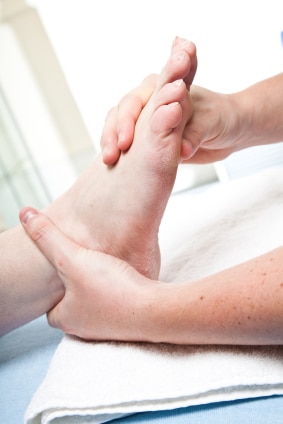Turf Toe

A turf toe is a sprain of the main joint of the big toe. The injury occurs when the toe is bent up into hyperextension. These types of sprains became prevalent in American football players after artificial turf was introduced, which led to the name turf toe. Artificial turf is much harder than natural turf and doesn’t have much “give” when the players force their feet into the ground. Turf toe became a common injury in the football world but is also very common in other sports and activities.
Anatomy
There are two joints that make up the big toe. The largest is the metatarsophalangeal joint (MTP), and in turf toe this joint is injured. The MTP joint is the one at the “ball of the foot”. The interphalangeal joint is a smaller joint near the nail
- Sesamoids: These two bones are in the flexor hallucis tendon and help it move easily. They also provide stability to the MTP joint by helping to distribute the weight placed on the forefoot. Like the patella (knee cap), the sesamoid bones act to increase the efficiency and therefore the force of the muscles that use the MTP joint.
- Flexor hallucis brevis (FHB): This tendon provides strength and balance to the big toe whenever the foot pushes off. The FHB is responsible for flexion of the toe at the MTP joint. The flexor halluces longus (FHL) flexes the toe at the interphalangeal joint.
- Plantar plate: This fibrous tissue stops the big toe from bending too far. The plantar complex surrounds the MTP joint and this structure, along with associated tendons and ligaments, hold it in place to prevent it from dislocating with the hyperextension. The plantar plate can be stretched or strained, have a partial tear or a complete tear.
- Collateral ligaments: These ligaments are on each side of the big toe and prevent the toe from going too far to either side. There is an inside (medial) and outside (lateral) collateral ligament.
Treatment
Turf toe is usually treated without surgery and nonsurgical treatments are determined by the severity of the injury.
- Grade 1: R.I.C.E. is recommended for this grade of injury: Rest, ice, compression and elevation. Pain isn’t severe and can be tolerated, and most athletes can continue participating in sports using a stiff-soled shoe. Another option for protection of the injury during activity is a ‘Morton’s’ extension; this is an insert with a stiff extension that sits underneath the MTP joint and prevents abnormal motion there.
- Grade 2: A walking boot may be recommended for a variable amount of time in order to keep the MTP joint stable and protected; the boot will also restrict motion yet allow ambulation. R.I.C.E. and a taping regimen for the MTP joint can help with treatment and most athletes rest 3 to 14 days before returning to activities. Taping should keep the toe in a flexed position during treatment. This often requires an offloading addition to the base of the boot.
- Grade 3: These injuries require a walking boot or cast to keep the big toe immobile and also taping to keep the MTP joint in a partially pointed down (flexed) position. As the injury becomes less intense, treatment will move down to Grade 2 and Grade 1. Physical therapy can be helpful as well.
Surgical treatment is not typically recommended for treating this injury. If symptoms persist surgery may be used to repair the soft tissues and restore the motion in the MTP joint. Surgery may also be recommended if the symptoms and findings on examination are consistent with an injury that would likely not respond to the above treatments. Additionally, some individuals are so active that surgical treatment is necessary for an early return to sports, work and activity. This is a decision that can only be made by the treating physician after a thorough work-up.
PRP injections are also an option to assist in both the surgical and non-surgical management of this particular injury.
Recovery
Turf toe can heal very well when treatment is started early after the injury. Pain and joint stiffness can last as a complication. Push off strength can also be affected and bunions can form and persist. Unless managed well, this injury may lead to residual pain and instability as well.
For more information on Turf Toe visit the




